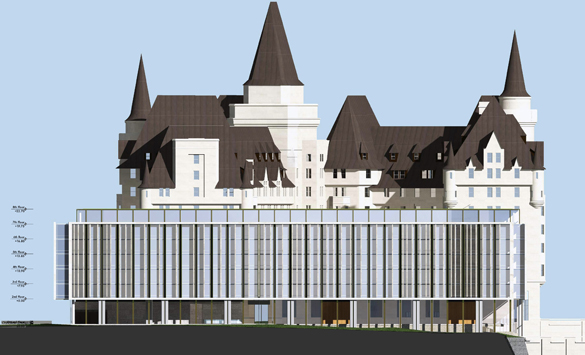Synthesis

“Its rather harsh reaction to the latest version of the redevelopment plan leaves one with the feeling that unless Heritage Ottawa gets the developer to construct an exact copy of the century-old hotel, it will never approve the expansion.”
(Mohammed Adam, Ottawa Citizen, June 11)
The sentiment expressed by Mohammed Adam in today’s Citizen reflects one of the most bewildering aspects of the debate around the proposed expansion of the Château Laurier: why do some people – like Mohammed Adam – think that the only alternatives are radical incompatibility or an ‘exact copy’? Why do they not realize that between these extremes there is plenty of room for intelligent, creative synthesis?
Ottawa is full of examples of such synthesis. Arthur Erickson’s 1979 addition to the Bank of Canada is uncompromisingly modern, but adopts the values of the historic building’s chaste, orderly Classicism. It’s what I would call ‘radical compatibility’. Gillin Engineering’s 2004 addition to the Lord Elgin Hotel is even more deferential; the new work is clearly distinguishable from the old to anyone who looks closely, but at a glance it blends seamlessly. Barry Padolsky’s 2010 addition to the Canadian Museum of Nature builds on the lines of the tower that was always meant to be there, and completes the idea in a modern language.
All of these successful designs have one thing in common. Each architect paid very careful attention not just to the style, but to the sensibility of the historic building, and produced an addition that would have a meaningful, thoughtful connection to it. This was a fundamental principle of all three designs, not an afterthought layered on with a series of tweaks. New adds to old, rather than colliding violently with it. This is precisely what all of the proposed designs for the Château Laurier have failed to do.
Mohammed Adam points out that the present design proposed for the Château is the third version of the project (it’s actually the fourth, but versions 1 and 2 are nearly indistinguishable). To him, that means that we should accept the design and ‘get on with it’. But since when is it a good idea to proceed with a bad idea just because you don’t have a good one? What the project’s critics have asked for all along is an excellent design, not merely a different one.
It cannot be said enough times: thoughtful criticism of the proposed expansion of the Château Laurier is not about disliking Modernism, or resistance to change. It’s about demanding the kind of excellence that the national capital deserves.
Peter Coffman
peter.coffman@carleton.ca